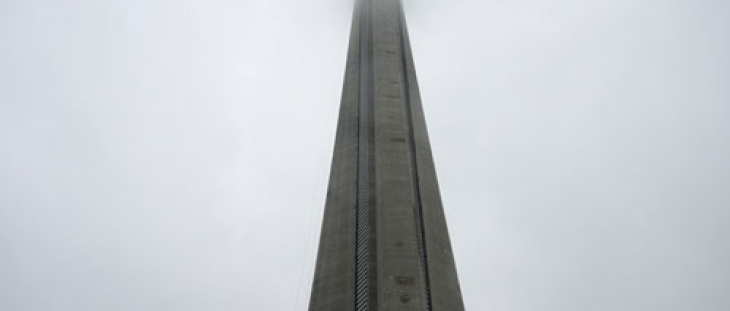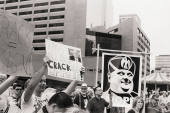
 It didn’t take long for this year’s budget process to reach the only logical conclusion, which was to stop the in-fighting and start talking about dissolving the city itself. One day city council was talking about saving a couple of small museums from cuts. The next day–screw it! We’re de-amalgamating! In fairness, nobody actually proposed immediate de-amalgamation. Paula Fletcher, leftist firebrand of Riverdale, actually proposed that the city ask the province to take preliminary steps in that direction. But her direction was plain: Let’s get the ball rolling. I wouldn’t normally trouble you with the specifics of what happened on city council, but I think we should put this in the bizarrely nonchalant context. Council was in the middle of discussing some aspects of the core service review, in all their mundane detail. Fletcher waded in to make three motions: First, that the city look at new revenue options for the 311 service, including changing the way those calls are charged internally. Second, that the council defer implementing changes to the 311 service until such time as the city manager issues a further report. Third, that we blow up Toronto. The speaker, Francis Nunziata, interrupted to point out that introducing a motion to blow up the city was out of order. Council was trying to debate something else at that exact moment. This was not the time to blow up the city. Fletcher challenged the decision, which meant that the rest of council was asked whether it was proper to introduce a motion calling for the blowing-up of Toronto in the middle of an unrelated debate. Sure, said council. They overruled the speaker 18-17. And with that, in the middle of the budget cuts, councillors actually started talking about breaking up the city. It was like one of those arguments that starts with forgetting to pick up the milk, and slowly spins out of control until someone says, “I don’t think we’re right for each other.” At first, the subject was debated with some eagerness, but then people started to worry. What about Waterfront Toronto? asked Councillor Raymond Cho, sounding like he’d just realized he’d lose custody of the dog. Then Giorgio Mammoliti, who never misses a chance to stand up and yell, stood up and yelled that Fletcher just didn’t want to deal with the $774 million deficit, which by increasingly common agreement doesn’t actually exist. As council politics morph from the siege of the Ford months into more of a free-flowing farce, deamalgamation is becoming a popular talking point. It appeals to aggrieved downtowners, tired of what feels like a hostile occupation. It appeals to aggrieved suburbanites, some of whom never warmed to the idea of the megacity in the first place. A few months ago I attended a packed community meeting in Downsview, where a sizeable new development is in the works. Planning staff were trying to tell rattled residents that growth is natural in a city like Toronto. One of the locals got up and said, “This is Downsview. We’ve always been Downsview. Toronto is encroaching on us!” Even the mayor is amenable. “Would I like to go back to the old Etobicoke?” he told the CBC. “Sure, if it didn’t cost us a dime. I think everybody would agree, ‘Let’s go back.’” But Rob Ford is right on this one: Many dimes would be spilled should this question be reopened. Demanding to break up the city is the parochial equivalent of Americans swearing they’re going to move to Canada every time a Republican gets elected. (That influx, somehow, never arrived.) Deamalgamation is an entertaining fantasy, but a lousy idea. This is not to say that amalgamation was a good idea in the first place. Mike Harris took a system that more or less worked, and sent it into a decade-long tizzy of reorganization to save money, and did it over the express wishes of its citizens, who voted against it in a plebiscite. This does not mean that another decade-long tizzy is in order. The City of Toronto has 50,000-odd employees. Bureaucracies are not the fastest-moving of creatures to begin with; less so when you throw them into disarray. It’s all well and good to fantasize about banishing Rob Ford to his suburb of solitude, but are you eager to split up the school boards again? Devolve Toronto Hydro back to separate electric systems? Spend years reestablishing accounting systems and procurement systems and human resources policies and, you know, computer leasing contracts? Less sexy now, isn’t it? Pre-amalgamation Toronto seems to be gaining a gauzy halo, a utopia that never really existed. People seem to forget that many of the hot-button issues before us were already amalgamated. Metro Toronto already had one police force, one fire department, and one TTC, which quite happily tried to kill streetcars without a Ford in sight. Nor was local determinism a panacea. The former City of Toronto was entirely capable of electing a right-wing mayor who refused to go to Pride and ruined the waterfront by selling it off to private developers, all with zero assistance from the good people of Etobicoke. Today, instead of being devolved to a series of councils, power is consolidated in the Mayor’s office and his loyalist-stacked committees. But that wasn’t amalgamation–that happened under David Miller. Moreover, amalgamation and downloading were two separate things. Even Ford spoke glowingly of the time when semi-autonomous Etobicoke had a surplus. Splitting up the city won’t return Toronto, or its constituent pieces, to the days when the provincial government footed the bill for things like welfare, transit expansion, and half of the TTC’s operating costs. Like all families, we fight when money gets tight. Deamalgamation wouldn’t fix that. It would just become another money pit. You can’t turn back time on a municipality any more than you can turn back time in a relationship. But you can fix things. Instead of making idle threats to break up, let’s talk about giving real powers to the community councils, which roughly correlate to the boundaries of the old cities. In the end, council voted solidly, and wisely, against Fletcher’s motion to open the door for deamalgamation. Getting a government you don’t like is a risk of democracy. “Let’s call the whole thing off” is not an answer. __ Ivor Tossell is Toronto Standard’s Urban Studies columnist.
It didn’t take long for this year’s budget process to reach the only logical conclusion, which was to stop the in-fighting and start talking about dissolving the city itself. One day city council was talking about saving a couple of small museums from cuts. The next day–screw it! We’re de-amalgamating! In fairness, nobody actually proposed immediate de-amalgamation. Paula Fletcher, leftist firebrand of Riverdale, actually proposed that the city ask the province to take preliminary steps in that direction. But her direction was plain: Let’s get the ball rolling. I wouldn’t normally trouble you with the specifics of what happened on city council, but I think we should put this in the bizarrely nonchalant context. Council was in the middle of discussing some aspects of the core service review, in all their mundane detail. Fletcher waded in to make three motions: First, that the city look at new revenue options for the 311 service, including changing the way those calls are charged internally. Second, that the council defer implementing changes to the 311 service until such time as the city manager issues a further report. Third, that we blow up Toronto. The speaker, Francis Nunziata, interrupted to point out that introducing a motion to blow up the city was out of order. Council was trying to debate something else at that exact moment. This was not the time to blow up the city. Fletcher challenged the decision, which meant that the rest of council was asked whether it was proper to introduce a motion calling for the blowing-up of Toronto in the middle of an unrelated debate. Sure, said council. They overruled the speaker 18-17. And with that, in the middle of the budget cuts, councillors actually started talking about breaking up the city. It was like one of those arguments that starts with forgetting to pick up the milk, and slowly spins out of control until someone says, “I don’t think we’re right for each other.” At first, the subject was debated with some eagerness, but then people started to worry. What about Waterfront Toronto? asked Councillor Raymond Cho, sounding like he’d just realized he’d lose custody of the dog. Then Giorgio Mammoliti, who never misses a chance to stand up and yell, stood up and yelled that Fletcher just didn’t want to deal with the $774 million deficit, which by increasingly common agreement doesn’t actually exist. As council politics morph from the siege of the Ford months into more of a free-flowing farce, deamalgamation is becoming a popular talking point. It appeals to aggrieved downtowners, tired of what feels like a hostile occupation. It appeals to aggrieved suburbanites, some of whom never warmed to the idea of the megacity in the first place. A few months ago I attended a packed community meeting in Downsview, where a sizeable new development is in the works. Planning staff were trying to tell rattled residents that growth is natural in a city like Toronto. One of the locals got up and said, “This is Downsview. We’ve always been Downsview. Toronto is encroaching on us!” Even the mayor is amenable. “Would I like to go back to the old Etobicoke?” he told the CBC. “Sure, if it didn’t cost us a dime. I think everybody would agree, ‘Let’s go back.’” But Rob Ford is right on this one: Many dimes would be spilled should this question be reopened. Demanding to break up the city is the parochial equivalent of Americans swearing they’re going to move to Canada every time a Republican gets elected. (That influx, somehow, never arrived.) Deamalgamation is an entertaining fantasy, but a lousy idea. This is not to say that amalgamation was a good idea in the first place. Mike Harris took a system that more or less worked, and sent it into a decade-long tizzy of reorganization to save money, and did it over the express wishes of its citizens, who voted against it in a plebiscite. This does not mean that another decade-long tizzy is in order. The City of Toronto has 50,000-odd employees. Bureaucracies are not the fastest-moving of creatures to begin with; less so when you throw them into disarray. It’s all well and good to fantasize about banishing Rob Ford to his suburb of solitude, but are you eager to split up the school boards again? Devolve Toronto Hydro back to separate electric systems? Spend years reestablishing accounting systems and procurement systems and human resources policies and, you know, computer leasing contracts? Less sexy now, isn’t it? Pre-amalgamation Toronto seems to be gaining a gauzy halo, a utopia that never really existed. People seem to forget that many of the hot-button issues before us were already amalgamated. Metro Toronto already had one police force, one fire department, and one TTC, which quite happily tried to kill streetcars without a Ford in sight. Nor was local determinism a panacea. The former City of Toronto was entirely capable of electing a right-wing mayor who refused to go to Pride and ruined the waterfront by selling it off to private developers, all with zero assistance from the good people of Etobicoke. Today, instead of being devolved to a series of councils, power is consolidated in the Mayor’s office and his loyalist-stacked committees. But that wasn’t amalgamation–that happened under David Miller. Moreover, amalgamation and downloading were two separate things. Even Ford spoke glowingly of the time when semi-autonomous Etobicoke had a surplus. Splitting up the city won’t return Toronto, or its constituent pieces, to the days when the provincial government footed the bill for things like welfare, transit expansion, and half of the TTC’s operating costs. Like all families, we fight when money gets tight. Deamalgamation wouldn’t fix that. It would just become another money pit. You can’t turn back time on a municipality any more than you can turn back time in a relationship. But you can fix things. Instead of making idle threats to break up, let’s talk about giving real powers to the community councils, which roughly correlate to the boundaries of the old cities. In the end, council voted solidly, and wisely, against Fletcher’s motion to open the door for deamalgamation. Getting a government you don’t like is a risk of democracy. “Let’s call the whole thing off” is not an answer. __ Ivor Tossell is Toronto Standard’s Urban Studies columnist.














